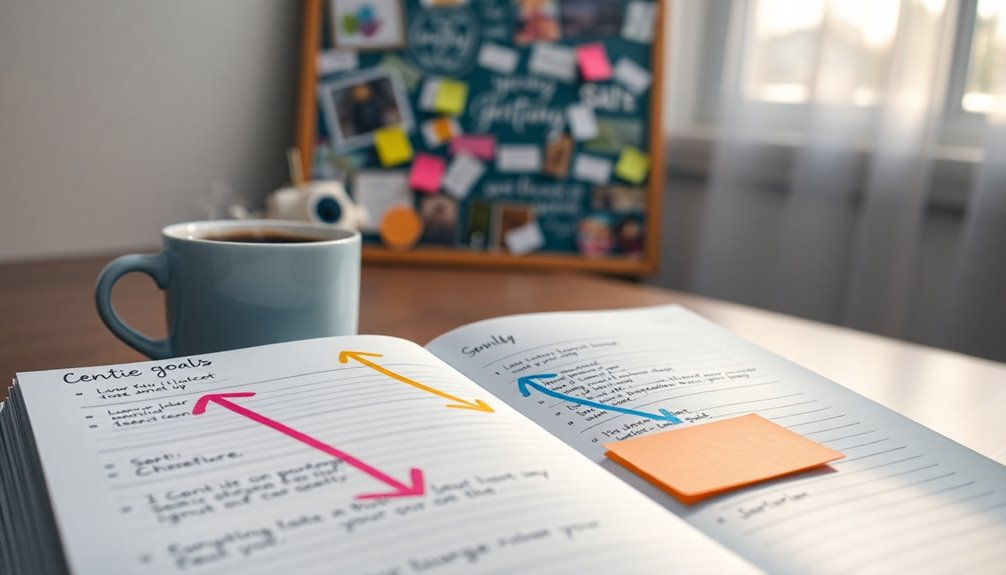Combining visualization with action steps transforms your ambitions into reality. Start by setting clear, specific goals that anchor your visualizations. Create a vision board that visually represents your objectives; this keeps your mindset focused and ignites motivation. Incorporate daily visualization practices to align your thoughts with your actions, making it easier to identify actionable steps. Break your goals into manageable milestones, and track your progress to maintain momentum. Embrace flexibility in your approach and celebrate achievements, no matter how small. This balanced strategy not only fosters success but also enriches your journey, so there's even more to explore.
Key Takeaways
- Set specific, measurable goals that align with your visualizations to create actionable steps towards achieving them.
- Create a vision board to visually represent your goals, making it easier to identify actionable steps that lead to success.
- Incorporate daily visualization routines at different times of the day to reinforce your goals and keep your actions aligned.
- Regularly track your progress and reflect on your journey to adjust your visualization techniques and action steps as needed.
- Celebrate small victories along the way to enhance motivation and reinforce your commitment to both visualization and action steps.
Understand the Power of Visualization

When you harness the power of visualization, you're not just daydreaming; you're actively shaping your reality. Visualization techniques allow you to create a mental image of your desired outcomes, making them feel more tangible and achievable. You're not simply imagining success; you're programming your mind to recognize opportunities and obstacles, which can lead to more effective decision-making.
Think about how athletes use visualization before competitions. They don't just hope for a win; they visualize every play, every move, and even the feeling of victory. This practice isn't exclusive to sports; you can apply it in your personal and professional life too. By employing visualization techniques, you're training your subconscious mind to align with your goals. This alignment can enhance your motivation, focus, and resilience, driving you to take action in ways you mightn't have thought possible.
Now, consider the visualization benefits. Research shows that mental imagery can improve performance, reduce anxiety, and foster a greater sense of control over your life.
When you visualize, you're not only fostering a positive mindset, but you're also building confidence that can permeate various aspects of your existence. This sense of belonging to a community of achievers can be incredibly empowering.
Set Clear, Specific Goals

Setting clear, specific goals is necessary if you want to transform your visualization into actionable outcomes. Without precise targets, your dreams can feel unattainable, leading to frustration rather than motivation. Goal setting isn't just a nice idea; it's an essential step that anchors your visualization techniques in reality.
First, break down your broader aspirations into smaller, achievable milestones. For instance, if you envision a successful career, specify what that looks like—perhaps it involves obtaining a specific certification or completing a project within a set timeframe. These tangible goals give you a roadmap, making it easier to navigate your journey.
Next, confirm your goals are measurable. Instead of saying, "I want to get fit," aim for, "I'll exercise for 30 minutes, five times a week." This clarity not only fuels your motivation but also allows you to track your progress. Additionally, having a structured plan, like a custom keto diet plan, can provide you with a tailored meal plan to support your health goals.
You'll find that celebrating these small victories reinforces your commitment and enhances your sense of belonging within your community.
Create a Vision Board

Creating a vision board can be a transformative step in manifesting your goals and aspirations. This visual representation of your dreams serves as a daily reminder of what you're working towards. By assembling images, quotes, and symbols that resonate with you, you not only clarify your objectives but also ignite a sense of belonging within a community of like-minded individuals.
Vision board benefits extend beyond mere aesthetics. They help you focus your energy on your aspirations, making it easier to identify actionable steps toward achieving them. When you regularly engage with your vision board, you reinforce your commitment to your goals, cultivating a mindset geared for success. Plus, seeing your goals in a visual format can enhance motivation and inspire creativity.
As you create your board, think about vision board examples that resonate with your values. You might include images that represent your career dreams, personal growth, or health goals. Perhaps you'll add quotes that uplift you or reminders of experiences that brought you joy. Each element should reflect not just individual aspirations but also the connections you share with others pursuing similar paths.
In the process of crafting your vision board, you'll foster a sense of community. By sharing your vision with friends or joining a group, you'll discover that pursuing your dreams doesn't have to be a solitary journey. Instead, it can be a collaborative effort, reinforcing your sense of belonging and shared purpose. Additionally, integrating techniques like Brainwave Guidance Program can further enhance your ability to focus and manifest your goals effectively.
Incorporate Daily Visualization Practices

Incorporating daily visualization practices can greatly enhance your ability to achieve your goals. By consistently engaging in visualization techniques, you'll create a mental roadmap that aligns your thoughts and actions. This practice isn't just about daydreaming; it's about embedding your aspirations deeply within your mind and reinforcing them daily.
Consider the following table to help structure your daily visualization practices:
| Time | Visualization Technique |
|---|---|
| Morning (5 mins) | Visualize your day's goals |
| Afternoon (5 mins) | Picture overcoming challenges |
| Evening (10 mins) | Reflect on achievements and future goals |
By dedicating just a few minutes each day, you can make a significant impact. In the morning, visualize your day's goals to set a positive tone. In the afternoon, picture yourself overcoming any challenges you might face. Finally, in the evening, reflect on what you've accomplished and envision what's next.
These daily practices help you create a strong mental framework, guiding your actions and decisions. When you make visualization a routine, you're not just wishing for success; you're training your mind to recognize opportunities and take action. Additionally, integrating mindfulness meditation into your daily routine can further enhance your focus and clarity, supporting your visualization efforts.
Embrace the power of daily visualization techniques, and watch how they transform your journey toward your goals. You're not alone in this endeavor—many find strength in shared practices, and by committing to these techniques together, you foster a sense of belonging and community.
Break Goals Into Actionable Steps

While visualizing your goals is an essential first step, breaking them down into actionable steps is what truly propels you forward. You need a structured approach that transforms your dreams into reality, and that's where action planning comes in. By outlining specific tasks, you create a roadmap that guides you through the often overwhelming journey of goal execution.
Start by identifying your overarching goals. What do you really want to achieve? Once you've pinpointed these aspirations, determine the smaller, manageable steps that lead to those big objectives.
For example, if your goal is to run a marathon, you might break it down into weekly training schedules, dietary adjustments, and rest days.
Next, prioritize these steps. Which actions will have the most significant impact on your progress? This prioritization not only helps you focus but also fosters a sense of achievement as you tick off completed tasks. Remember, it's not just about moving forward; it's about making consistent progress that aligns with your vision.
Additionally, establish a timeline for each action item. Deadlines create urgency, pushing you to stay committed. Regularly reviewing your progress will help you adapt your plan if necessary, ensuring you're always aligned with your ultimate goal. Incorporating tools like mini band workouts can also serve as a practical action step to enhance your physical fitness journey.
In this way, breaking down your goals into actionable steps not only clarifies your path but also cultivates a sense of belonging within a community of goal-oriented individuals. You're not just dreaming; you're taking tangible steps toward achieving your aspirations.
Use Affirmations for Motivation

Once you've broken down your goals into actionable steps, it's time to harness the power of affirmations to fuel your motivation. Affirmations can greatly enhance your affirmation effectiveness by reinforcing positive beliefs about your capabilities and potential. When you repeat affirmations daily, you're not just saying words; you're actively reshaping your mindset to align with your goals.
To maximize the impact of your affirmations, combine them with visualization techniques. Picture yourself achieving your goals as you recite positive statements. For instance, if your goal is to excel in your career, you might say, "I am confident and prepared to take on new challenges."
While saying this, visualize yourself in a successful work environment, feeling the pride and excitement of accomplishment. This dual approach helps embed these positive beliefs deeper into your subconscious.
It's vital to choose affirmations that resonate with you personally. Tailor them to reflect your unique aspirations and values. When you believe in the words you're repeating, the motivation you gain will be more profound and genuine. Each time you face obstacles, your affirmations can serve as a reminder of your strength and resilience, pushing you to take the necessary action steps towards your objectives.
Track Your Progress Regularly

Tracking your progress regularly is vital for maintaining momentum and ensuring you stay on course toward your goals. By implementing consistent weekly reflections and progress check-ins, you can gain valuable insights into your journey, allowing you to celebrate successes and identify areas for improvement. This habit not only fosters accountability but also deepens your connection to your aspirations. Additionally, understanding the challenges and risks associated with knee replacement surgery can help you make more informed decisions about your health and wellness journey.
Consider the following table to visualize your tracking process:
| Week | Reflection Summary |
|---|---|
| Week 1 | Achieved initial goals; felt motivated. |
| Week 2 | Faced challenges; re-evaluated strategies. |
| Week 3 | Celebrated small wins; adapted to changes. |
Each week, take a moment to reflect on what worked, what didn't, and how you felt throughout the process. This isn't just about measuring success; it's about understanding your emotional journey, which is critical for long-term commitment. As you engage in these progress check-ins, you'll notice patterns emerge that can guide your future actions.
Visualize Overcoming Obstacles

Visualizing your path to conquering obstacles can be a game changer in your personal development journey. When you harness the power of mental imagery, you create a vivid picture of success that helps you navigate through challenges. This practice isn't just wishful thinking; it's a strategic approach to problem-solving that can enhance your resilience and confidence.
Imagine facing a significant challenge, whether it's a career setback or a personal struggle. By visualizing yourself successfully maneuvering that situation, you're not merely daydreaming. You're training your brain to recognize potential solutions and pathways. This mental rehearsal allows you to prepare emotionally and psychologically, making those obstacles feel less overwhelming.
When you visualize overcoming challenges, you're actively engaging in a process that primes you for success.
Moreover, mental imagery fosters a sense of belonging. As you envision yourself overcoming hurdles, you're not alone in that space. You're part of a broader community of individuals who aspire for growth and resilience. This shared experience can be incredibly motivating, reinforcing the notion that we all face challenges and can emerge stronger.
Stay Flexible and Adaptable

How can staying flexible and adaptable transform your approach to challenges? It's simple: life's unpredictability demands that you adjust your methods and strategies. By embracing flexibility, you're not just reacting to obstacles; you're proactively steering your journey, making you more resilient and effective. This adaptability is where visualization techniques come into play.
When you visualize your goals, consider that the path may shift unexpectedly. Instead of clinging rigidly to a single outcome, allow your mind to explore various scenarios and solutions.
As you refine your visualization practice, you'll discover the power of adapting strategies in real time. Picture yourself facing a hurdle; instead of feeling defeated, visualize alternative routes to success. This mindset not only enhances your problem-solving skills but also fosters a sense of belonging within your community. When you share your adaptability with others, you create an environment where collective growth flourishes.
Moreover, being flexible encourages collaboration. It opens the door to new ideas and perspectives, allowing you to learn from those around you. Remember, you're not alone in your journey. By staying adaptable, you build stronger connections and support networks that enrich your experience. For instance, the Fixing Elbow Pain System offers components that emphasize prevention measures and pre-habilitation techniques, showcasing how adaptability can lead to innovative solutions.
Ultimately, flexibility isn't a sign of weakness; it's a strength that empowers you to navigate challenges with confidence. So, as you incorporate visualization techniques into your action steps, commit to staying adaptable. This dynamic approach will transform not only how you tackle obstacles but also how you connect with others on the same path.
Celebrate Your Achievements

Celebrating your achievements is more than just a moment of joy; it's an essential component of personal growth and motivation. When you take the time to acknowledge your successes, you're not only reflecting on your progress but also reinforcing your commitment to future goals. This practice cultivates gratitude, helping you appreciate how far you've come and the effort you've put in. Additionally, celebrating small victories can boost your motivation, similar to how a plant-based diet can enhance overall health and well-being.
To make celebration a regular part of your journey, consider these three strategies:
- Keep a Success Journal: Document your achievements, no matter how small. This will serve as a tangible reminder of your progress, making it easier to reflect on your journey during challenging times.
- Share Your Wins: Don't hesitate to tell friends, family, or colleagues about your accomplishments. Sharing your successes fosters a sense of belonging and encourages others to celebrate with you, creating a supportive community.
- Reward Yourself: Set aside time to treat yourself when you reach a goal. Whether it's a day off, a special meal, or a fun outing, these rewards can reinforce your motivation and make the journey enjoyable.
Frequently Asked Questions
Can Visualization Techniques Be Used for Team Goals as Well?
Absolutely, you can use visualization techniques for team goals. By fostering team collaboration, visualization creates a shared vision that aligns everyone's efforts. It helps clarify objectives, making each member accountable for their role.
When you visualize success collectively, it cultivates a sense of belonging and motivation among team members. This not only enhances commitment but also drives performance, ensuring that everyone feels invested in achieving the common goal together.
How Long Should I Spend on Visualization Each Day?
Imagine spending just ten minutes each day visualizing your goals, like planting seeds in a garden. The visualization duration doesn't have to be long, but consistency boosts visualization effectiveness.
You'll find that this small commitment can create a profound sense of belonging and purpose, aligning your thoughts with your actions. Embrace this practice daily, and watch how your aspirations flourish, just as a well-tended garden thrives under the sun.
Is There a Specific Time of Day Best for Visualization?
There isn't a one-size-fits-all answer for the best time to visualize, but morning visualizations can set a positive tone for your day, aligning your mindset with your goals.
On the other hand, evening visualizations allow you to reflect on your day and reinforce your aspirations before sleep.
Consider experimenting with both times to see what resonates with you and boosts your motivation. Ultimately, it's about finding the rhythm that feels right for you.
What if My Visualization Feels Unrealistic or Overwhelming?
What if your visualization feels unrealistic or overwhelming? You're not alone in managing doubts. Start by breaking down your goals into smaller, achievable steps. This makes the vision seem more attainable and less intimidating. Focus on each step, celebrating progress along the way.
Can Visualization Help With Anxiety or Stress Relief?
Yes, visualization can greatly help with anxiety and stress relief. By creating vivid mental images of calm and safe spaces, you're training your mind to cope better with overwhelming feelings. This technique serves as a powerful coping strategy, allowing you to regain control over your mental health.
It fosters a sense of belonging, as you envision supportive environments and connections, making it easier to navigate life's challenges with resilience and confidence.
Conclusion
Incorporating visualization with actionable steps can transform your journey toward success. By setting specific goals and regularly tracking your progress, you'll not only stay motivated but also master the mindset needed to overcome obstacles. Remember, flexibility fosters growth, allowing you to adapt and thrive. So, as you celebrate your achievements, recognize that this powerful pairing of pictures and plans can propel you forward. Embrace the dynamic dance of visualization and action to reveal your fullest potential!



